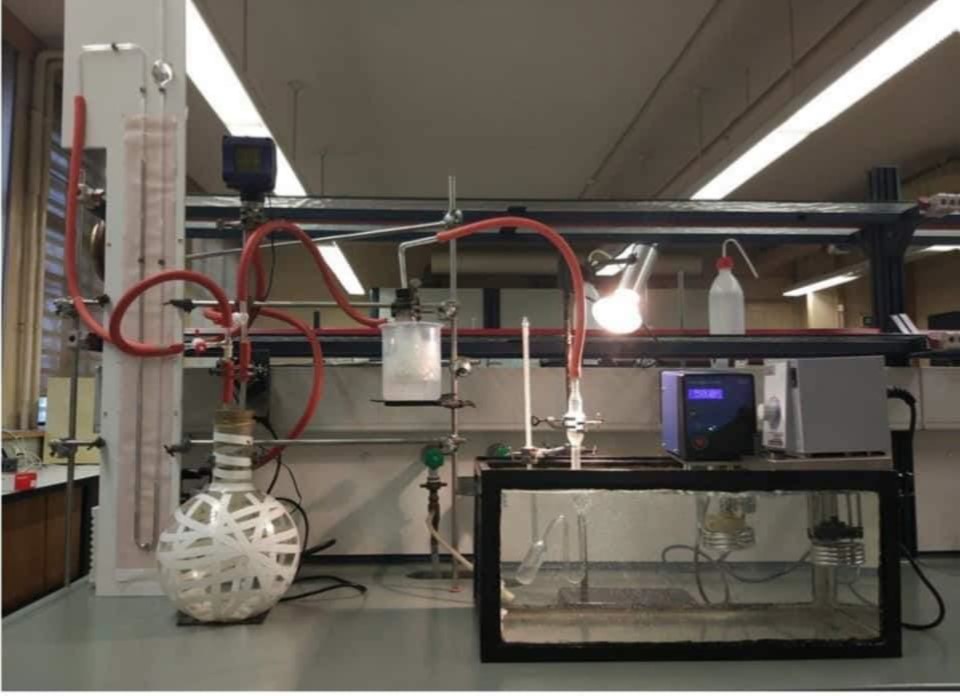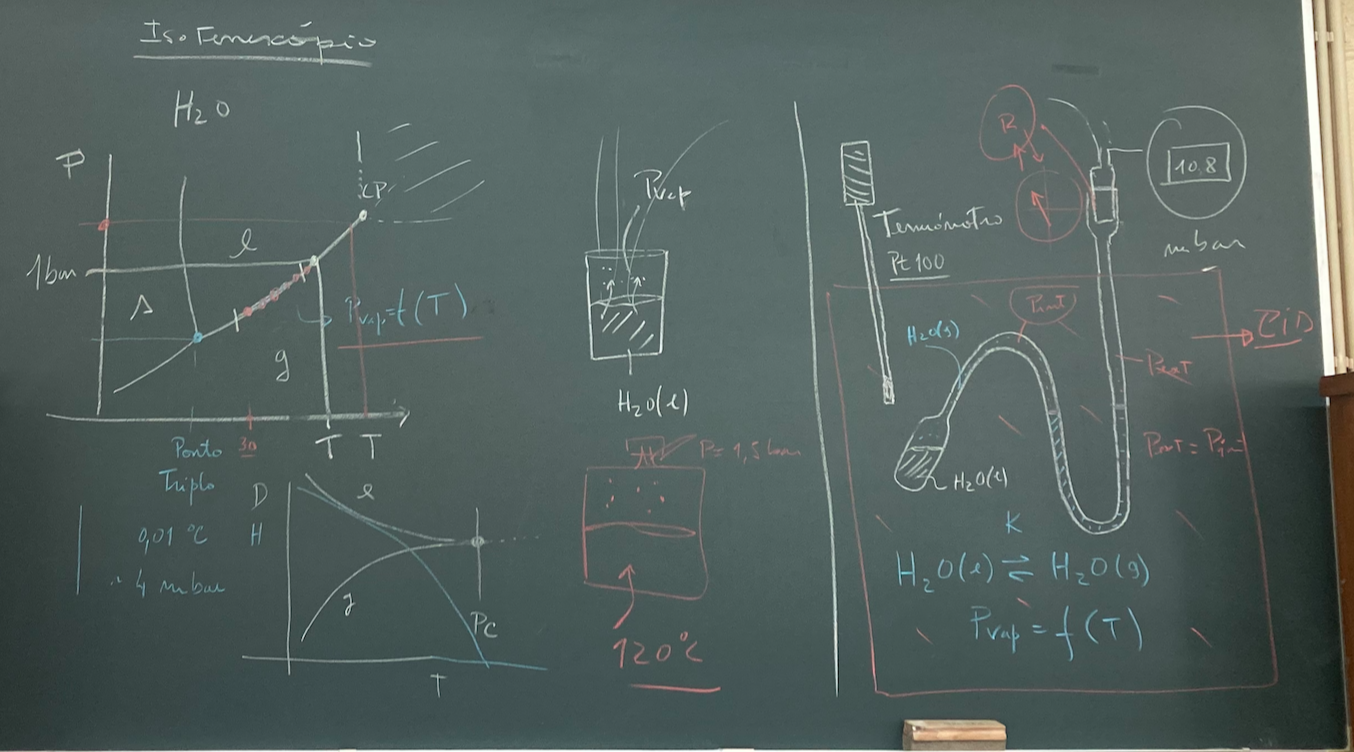Laboratório de Química Física
Lista de secções
-
Notas das diferentes componentes de avaliação.
Segue o link para ficheiro
................ LINK
Por favor, qualquer dúvida deverá ser esclarecida pelo seguinte email: lbsantos@fc.up.pt (Luis Santos)
com identificação explícita do estudante..
obrigado
Luís
-
Laboratório de Química Física
Código: Q2006 Sigla: Q2006 Nível: 200
To develop student’s skills for experimental work. This will be achieved through the accomplishment of physical chemistry experiments involving the determination of thermodynamic and kinetics parameters, analysis and interpretation of results, and writing of scientific reports.
Gibbs Energy Surface diagram ... P and T coordinates of a pure compound
General thermodynamic equilibrium between 2 phases of matter (α and β):
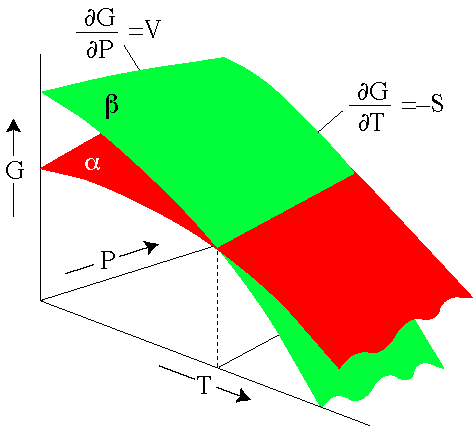
Triple points, data & examples

-
LABQF2024: Plano das aulas:

Distribuição dos grupos pelos trabalhos práticos:
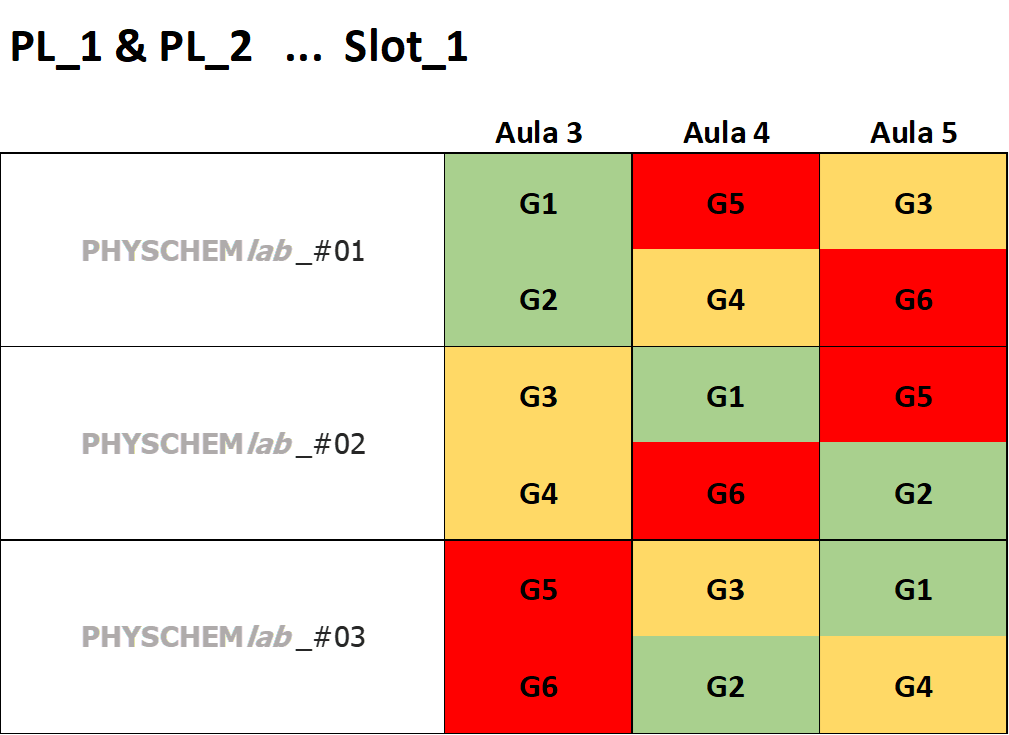

EMAIL PARA CONTACTO E DÚVIDAS:
labqfdqbfcup@gmail.com
Lista de Trabalhos Práticos
SLOT_1
PHYSCHEMlab_#01 VAPOR LIQUID EQUILIBRIUM: ISOTINESCOPE METHOD
PHYSCHEMlab_#02 SOLID_LIQUID EQUILIBRIUM: BINARY SYSTEM: BIPHENYL + NAPHTHALENE
PHYSCHEMlab_#03 IONIZATION EQUILIBRIUM OF GLYCYLGLYCINE
SLOT_2
PHYSCHEMlab_#04 VAPOR LIQUID EQUILIBRIUM: EBULLIOMETRY METHOD
PHYSCHEMlab_#05 MOLECULAR ENERGETICS: COMBUSTION CALORIMETRY
PHYSCHEMlab_#06 RATE OF REDUCTION OF HEXACYANOFERRATE(III) BY ASCORBIC ACID
Poster Template:
Link to the .pptx template file
- Envio dos Posters dos trabalhos laboratoriais:
a) Em formato .pdf para o e-mail: "labqfdqbfcup@gmail.com" ;
b) O "assunto" do email deve de conter o nome do ficheiro em anexo;
c) As mensagens de e-mail devem de ser enviadas com cópia para todos os membros do grupo;
d) Nomenclatura dos ficheiros .pdf: (e.g. PL1_G1_03.pdf para turma PL1, Grupo G1, Trabalho #3).
Avaliação
A avaliação nesta disciplina envolve três componentes principais:
a) a Nota Prática, NP, que contempla o desempenho e envolvimento do estudante na realização dos trabalhos práticos e a classsificação dos Posters relativos a cada trabalho (peso de 60%);
b) a Nota das Discussões Intercalares dos Posters, ND_S1 e ND_S2, que contemplam o desempenho de cada estudante na apresentação e discussão dos seus Posters (peso de 10% + 10% = 20%); estas discussões intercalares ocorrerão na aula após a realização dos três trabalhos práticos de cada SLOT (SLOT_1 e SLOT_2);
c) a Nota do Trabalho Individual, NTI, que envolve a classificação do trabalho individual que foi atribuído a cada estudante (peso de 20%); este trabalho é um powerpoint de 5 slides, sem apresentação oral, sobre um tema relacionado com a magnífica área da Química-Física.
A nota NTI será usada em caso de contribuição positiva para a nota final.
...
A nota final, NF, da disciplina é então calculada usando a seguinte fórmula:
NF = 0.6 x NP + 0.1 x (ND_S1 + ND_S2) + 0.2 x NTI
A nota NTI será usada em caso de contribuição positiva para a nota final.
NF = (0.6 x NP + 0.1 x (ND_S1 + ND_S2))x1.250
Sem a contribuição da nota NTI.
-----------------------------------------------------------------------------------------------------------Aula de discussão dos trabalhos práticos (Slot_1)
Guia de perguntas
A discussão dos posters realizados pelos estudantes será baseada nas seguintes perguntas:
(cada estudante responderá a uma das cinco perguntas principais e eventualmente a uma das secundárias)
Perguntas principais:
1 - Qual o objetivo do trabalho?
2 - Como se fazem as medições experimentais?
3 - Que resultados se obtiveram?
4 - Como se faz o tratamento de dados?
5 - Que conclusões se obtiveram?
Perguntas secundárias:
6 - O que mais gostou deste trabalho?
7 - O que falhou ou pode falhar na realização experimental?
8 - Como se pode melhorar este trabalho?
9 - Onde se podem aplicar estes resultados?
10 - O que aprendeu neste trabalho?
11 - O que já sabia deste trabalho antes da sua realização?
12 - Qual foi a sua contribuição para este trabalho?
13 - Qual foi a sua contribuição para o poster?
14 - Que resultados indiretos pode derivar dos resultados experimentais?
15 - Qual das perguntas anteriores prefere? -
Temas para trabalhos individuais no link abaixo:
Lista de temas individuais LQF ..... link
Envio dos trabalhos individuais, em formato pdf, até ao dia 31 de maio de 2024:
1. Nome do Ficheiro PL#_LABQF2024_##.pdf (ex. PL1_LABQF2023_01.pdf ... para turma PL1, Trabalho #01 )
2. Para o e-mail da disciplina: "labqfdqbfcup@gmail.com"
3. O "assunto" do e-mail deve conter o nome do ficheiro em anexo.
Structure of the presentation
1 cover slide + 5 Slides (references in footnote) - English text.
No oral presentation, slides only.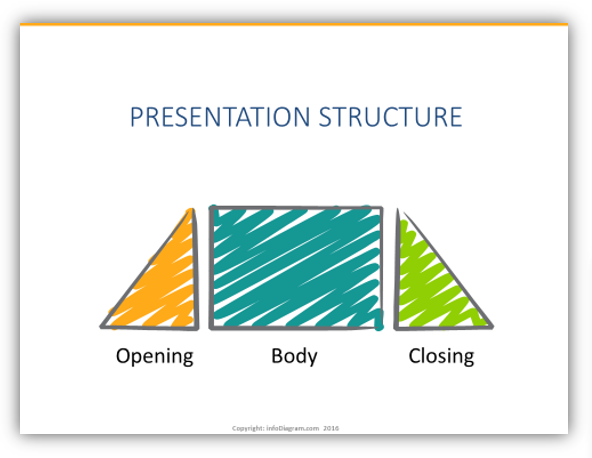
"Topic...."
Some tips to be followed:– Explanation/demonstration of your subject.
– What is it? How do you define it?
- How is it measured?
– What information can we get from it?
– Example of application or case study.
– Curiosity related to the topic!
Slide template LQF 2023/2024 ...
link .............................. -
SLOT 1 de Trabalhos Práticos
Vídeos gravados na aula de introdução aos três primeiros trabalhos práticos, lecionada pelo Prof. Luís Belchior em 22/02/2024.
S01E01: TP1 - Vapor-liquid equilibrium; isoteniscope method
S01E02: TP2 - Solid-liquid equilibrium; binary mixture biphenyl + naphthalene
S01E03: TP3 - Ionization equilibrium of glycylglycine
SLOT 2 de Trabalhos Práticos
Vídeos gravados na aula de introdução aos três últimos trabalhos práticos, lecionada pelo Prof. Luís Belchior em 20/02/2024.
S02E01: TP4 - Vapor pressure of alcohols by ebulliometry
S02E02: TP5 - Energetics of materials by combustion calorimetry
-
Some Slides about Phase equilibrium
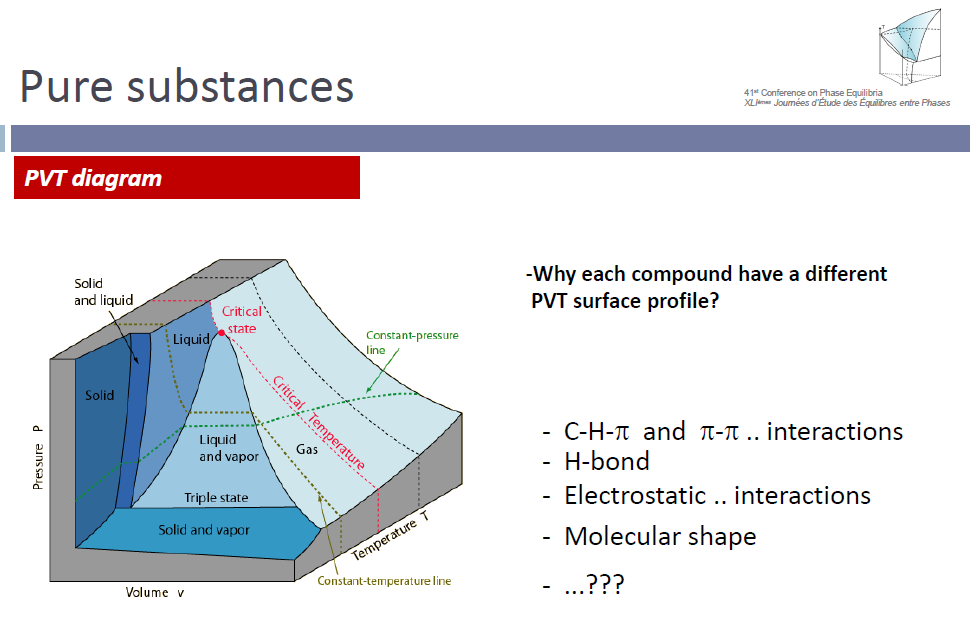
Liquid-vapor equilibrium (some considerations)
Link ..to text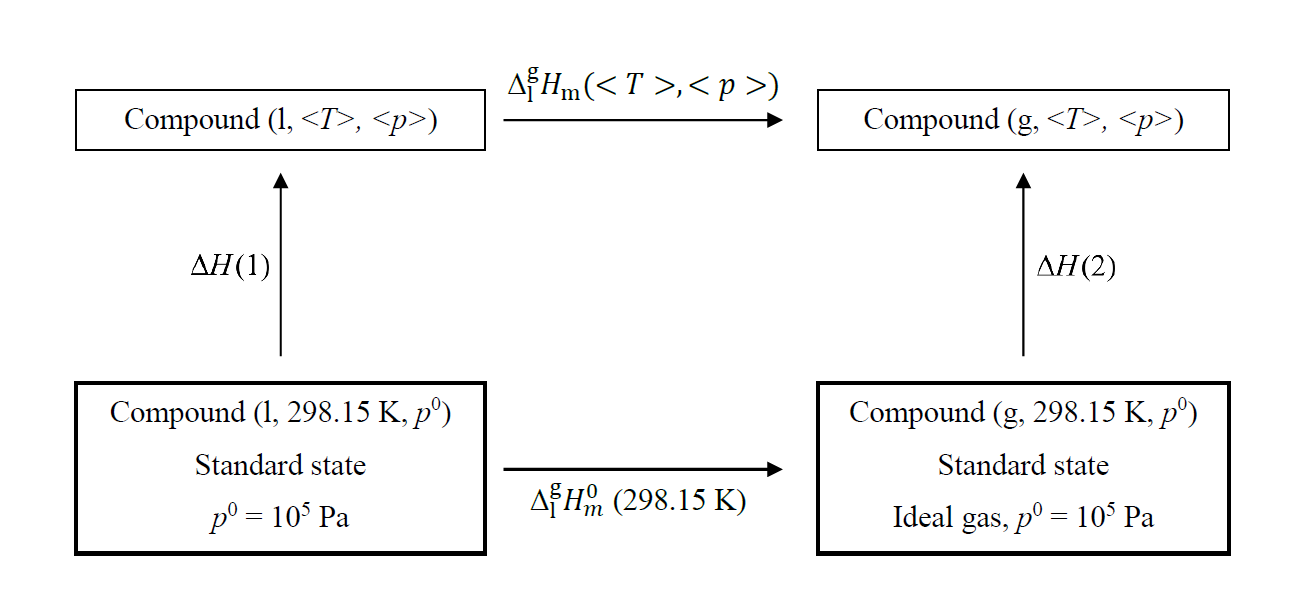
Working example for Benzene
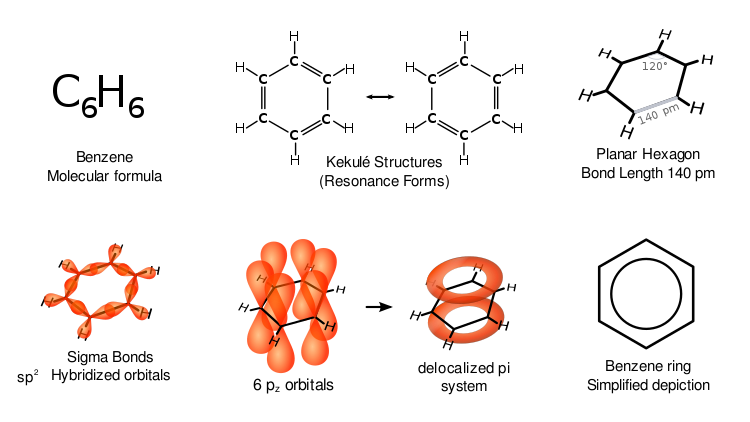
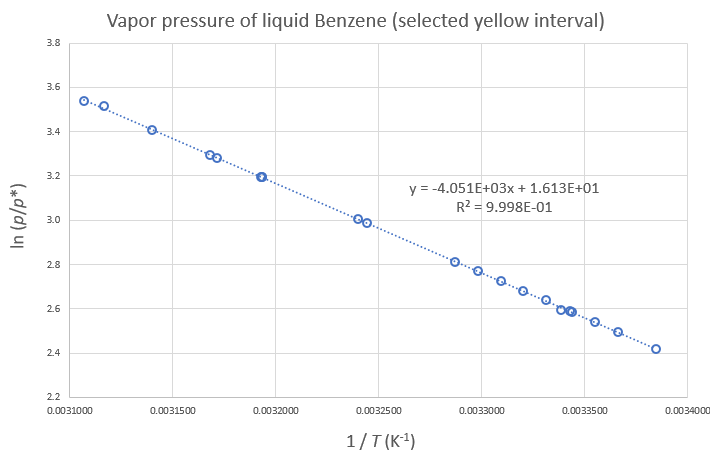
-
PHYSCHEMlab_#01
Auxiliar Suporte Materials:Pictures .....Isoteniscope details ... Picture Link ...Temperature monitor(Pt1000) ... Picture Link ...PID Temperature Controller (Bath) ... Picture Link ...Vacuum pump (Membrane double stage) ... Picture Link ...Instrumentations data information ....Pressure Sensor – WIKA - Universal Pressure Transmitters UT-10
https://en.wika.com/upload/OI_UT_1x_en_8705.pdf
VWR digital Thermometer TD110 Pt1000
HUBER Compatible PID temperature Control CC1
https://www.huber-online.com/download/manuals/archive/Compatible_Control_CC1_CC2_CC3_V2.0-08_EN.pdf
BÜCHI Vac V-500 – Vacuum
https://www.americaninstrument.com/pdf/5576A-VAC-PUMP.pdf
-
PHYSCHEMlab_#02

Paper_#04_01 ...paper JACS
Paper_#04_02 ... paper Phywe
LAB Demo Lecture.....
PANOPTO link ......
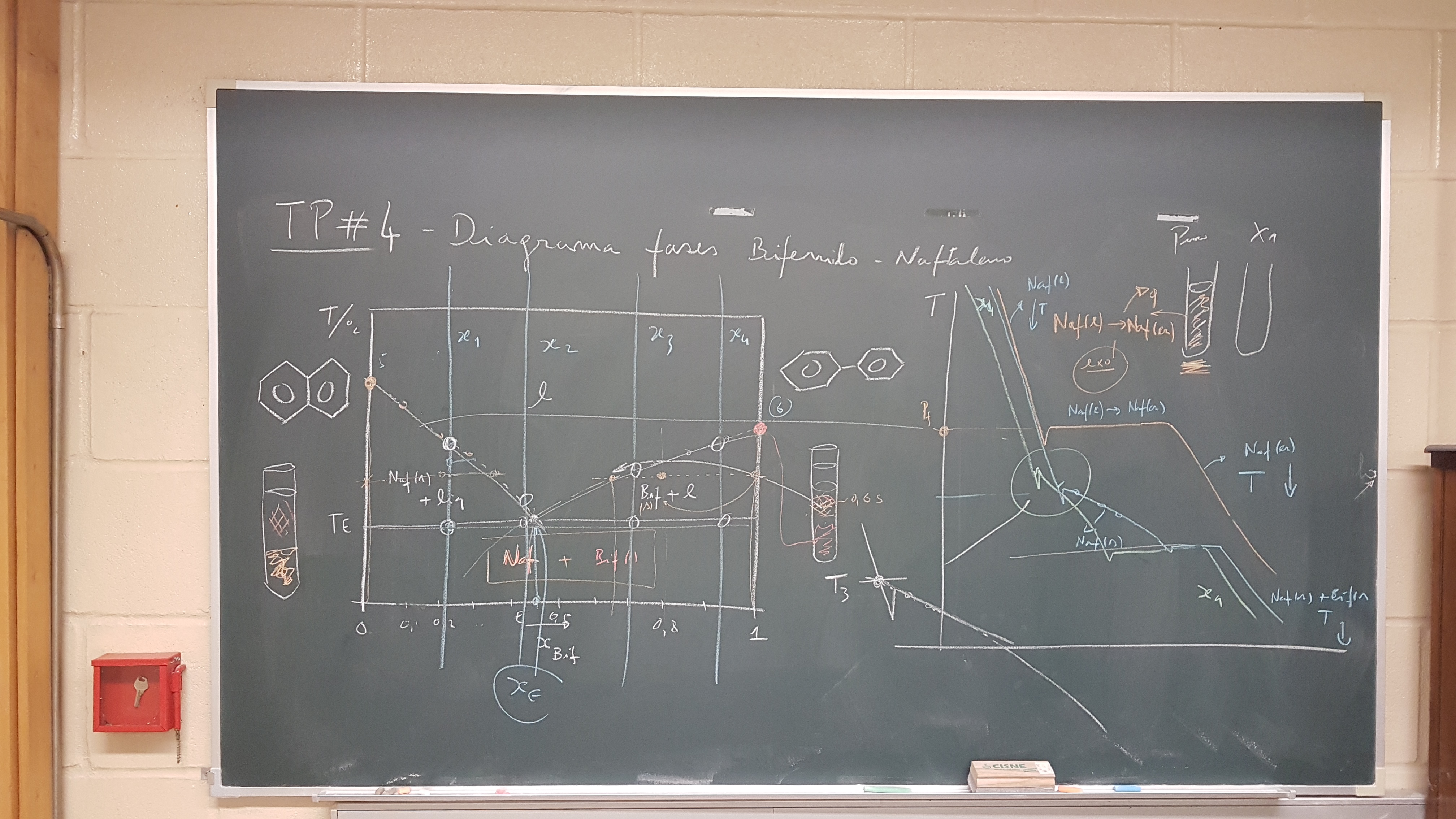
Bif & NAF ... screen Shot

Experimental results & details:
Instrumentation:Datalogger: Agilent model 34972A LXI Data Acquisition / Data Logger Switch Unit. .....6 1/2-digit (22-bit) internal DMM.
PC + Agilent Bench Link Software.
Temperature sensor = Thermocouple type T
https://www.thermocoupleinfo.com/type-t-thermocouple.htm
It consist of positive leg made of an Copper wire and negative leg made of Constantan (Cu & Cu-Ni) alloy wire
Type T Accuracy (whichever is greater):
- Standard: +/- 1.0C or +/- .75%
- Special Limits of Error: +/- 0.5C or 0.4%
Additional information :
link to EXCEL data File: Link ......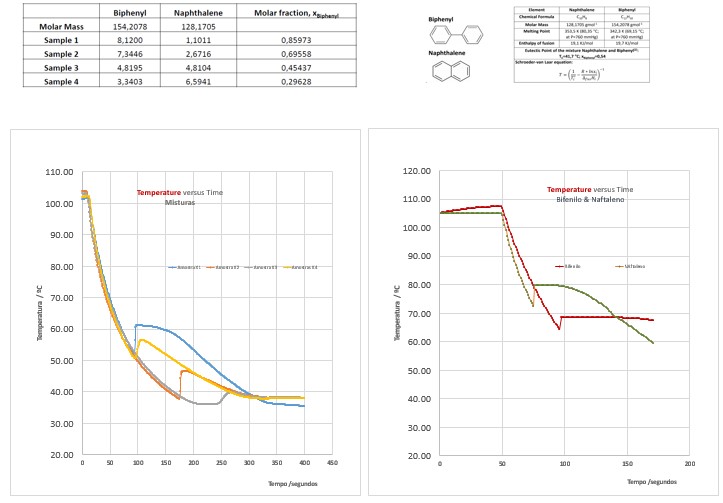
-
PHYSCHEMlab_#03
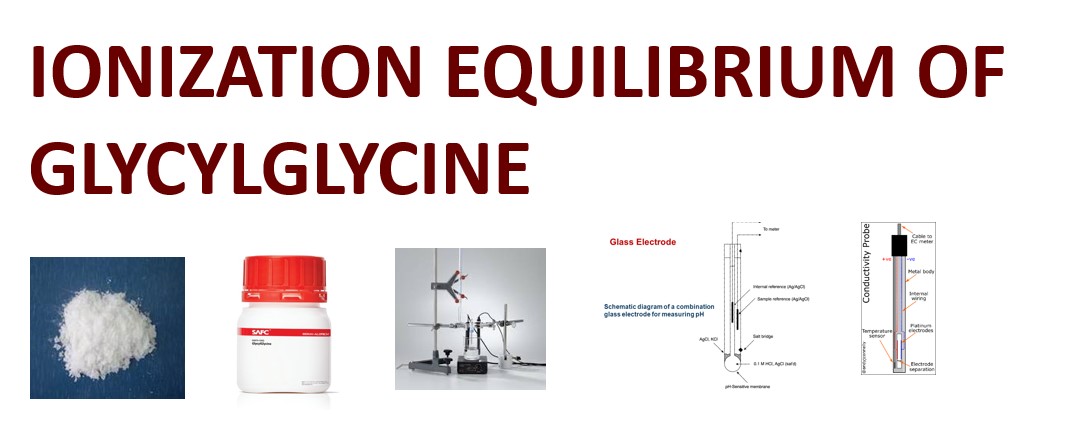
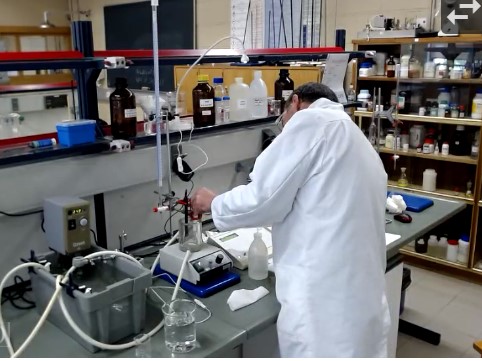
Electrolyte Conductivity measurements RADIOMETER ... Link
JACS paper ... Link
Paper Chemical education .... Link
NIST_conductivity ..... LinkLink to PANOPTO ..... lecture
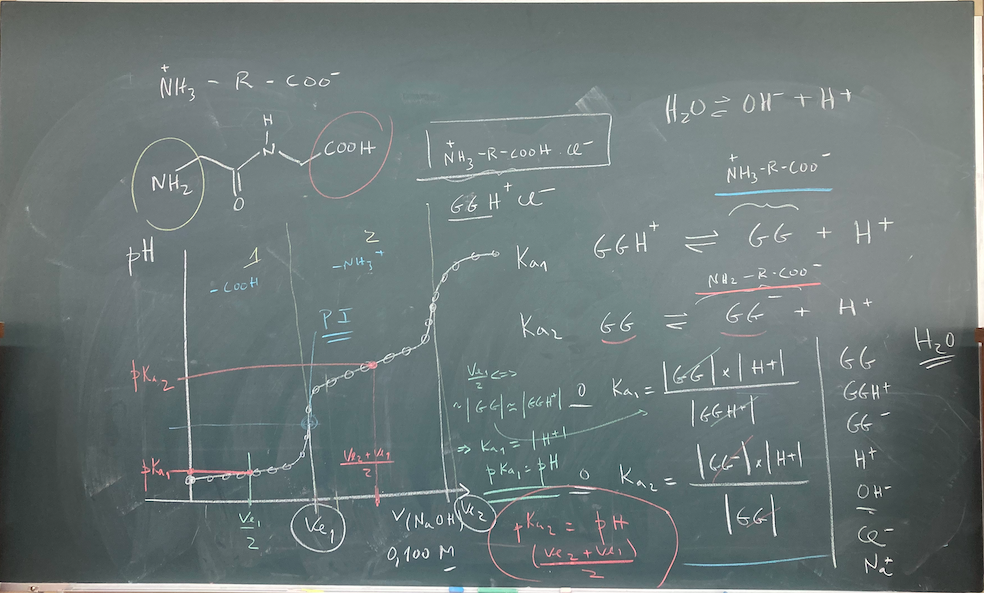
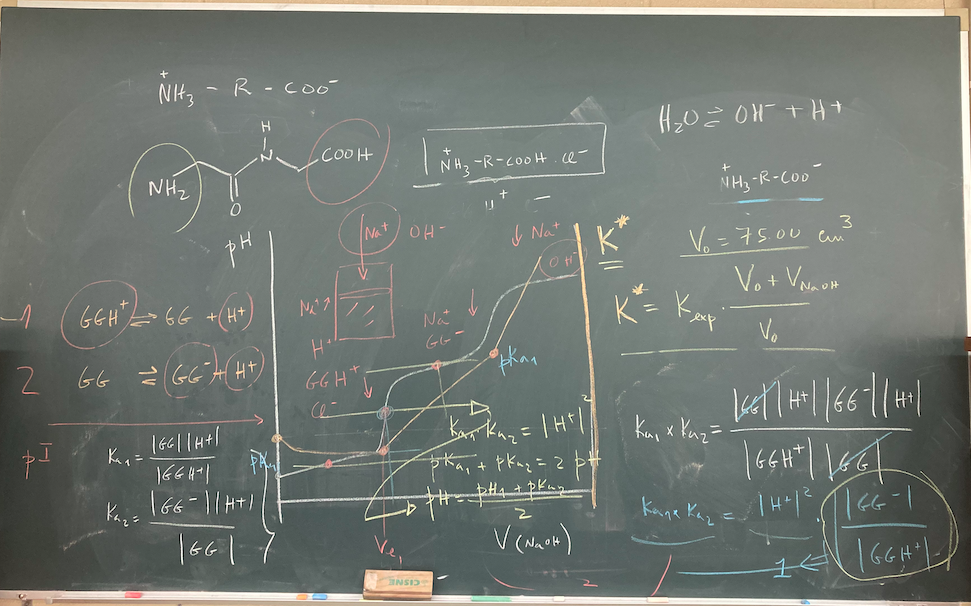
Titration .... pH & K
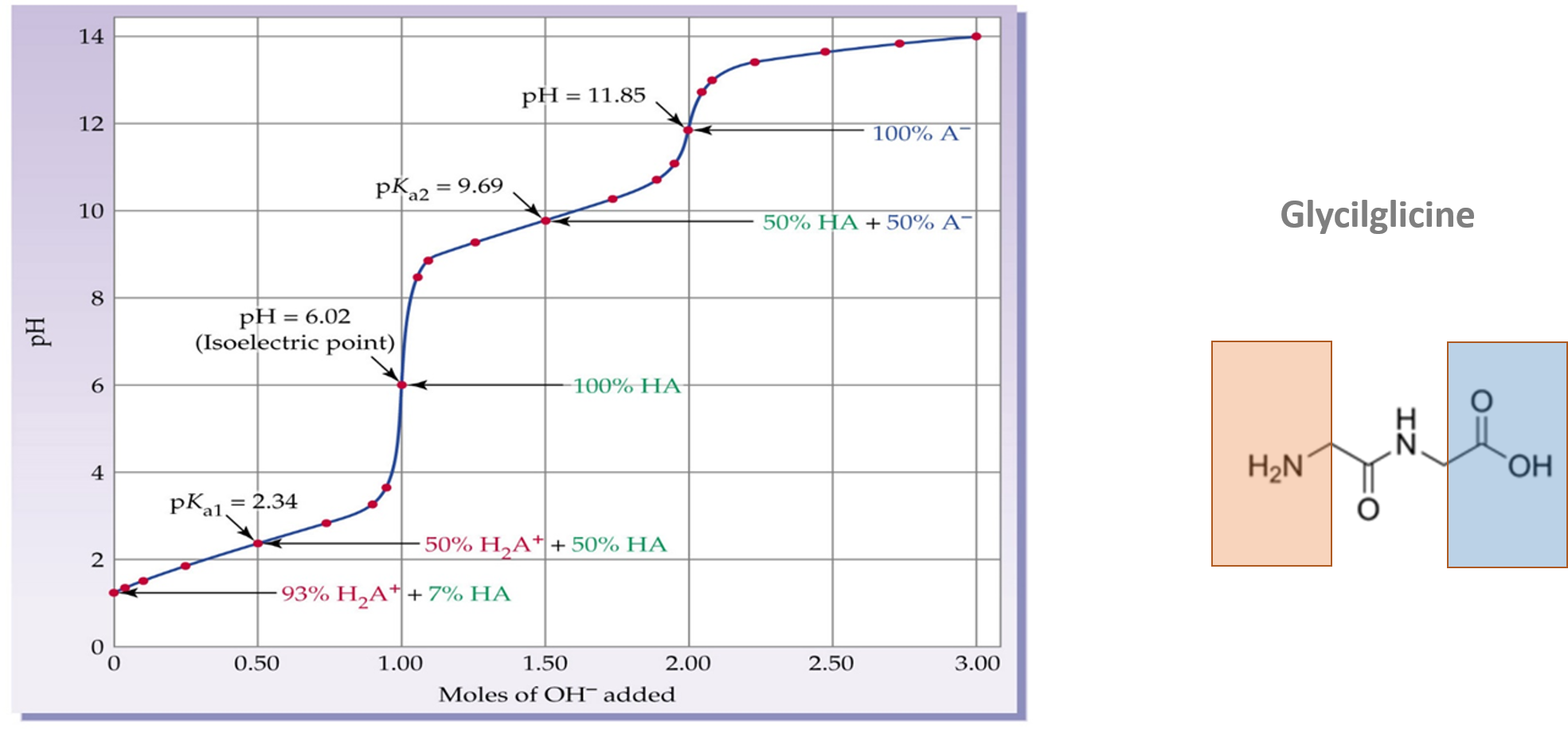
Instrumentation: Experimental setup.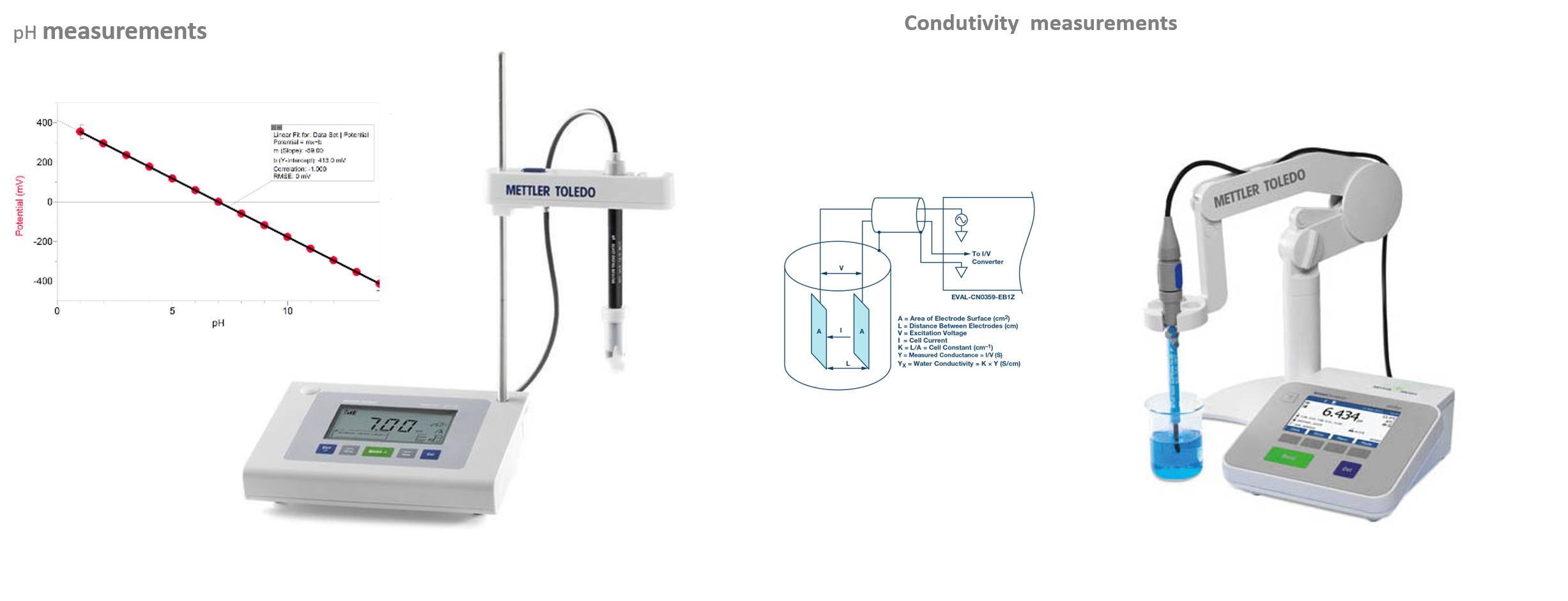
pH ... Titration Curve & Speciation SIMULATOR
Link to Excel File .... NOVA VERSÃO !!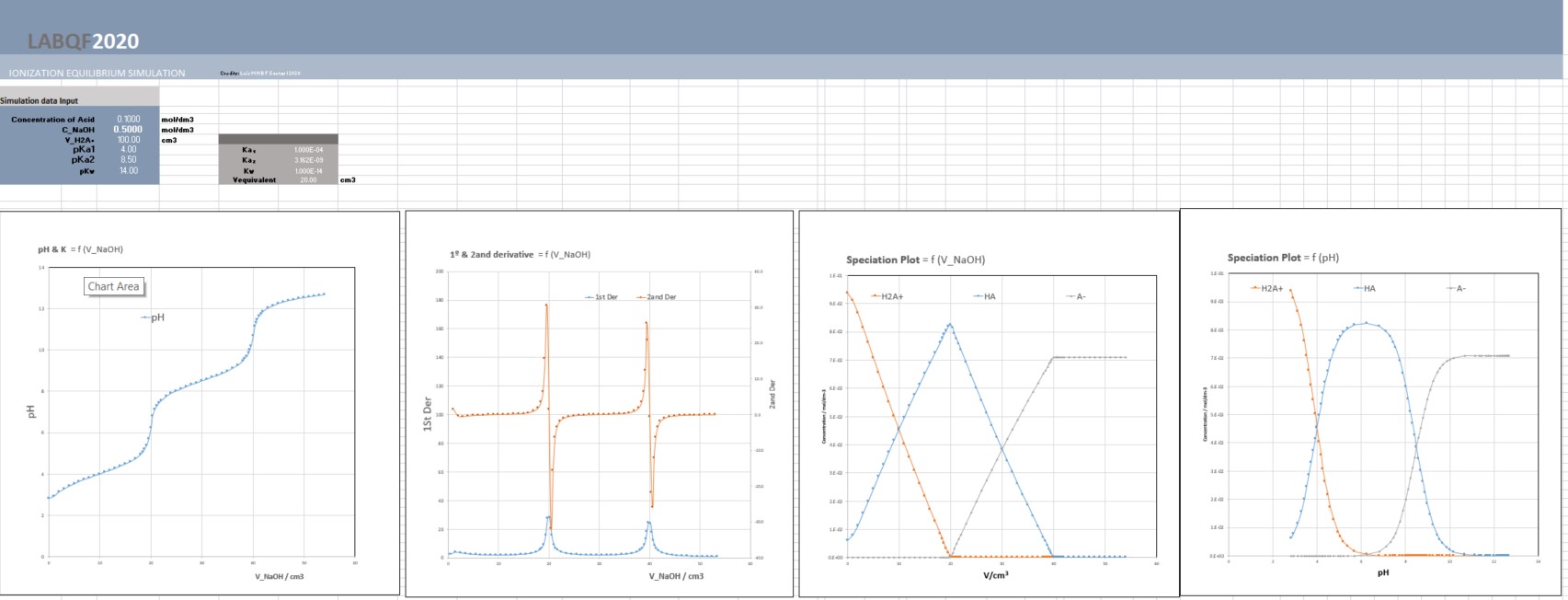
Experimental Results:
link to excel File: ....... Link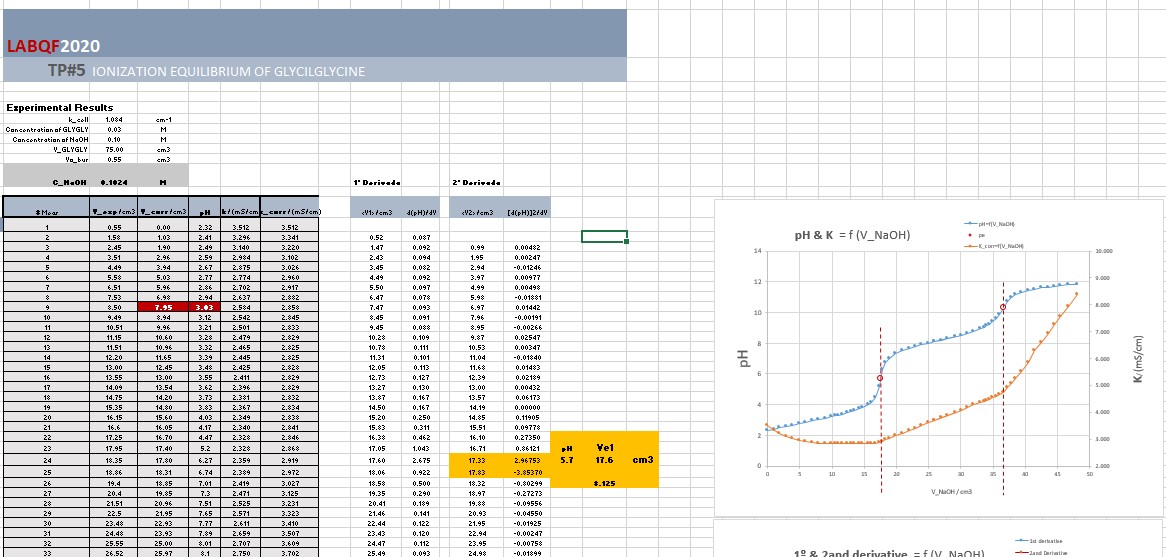
-
PHYSCHEMlab_#04
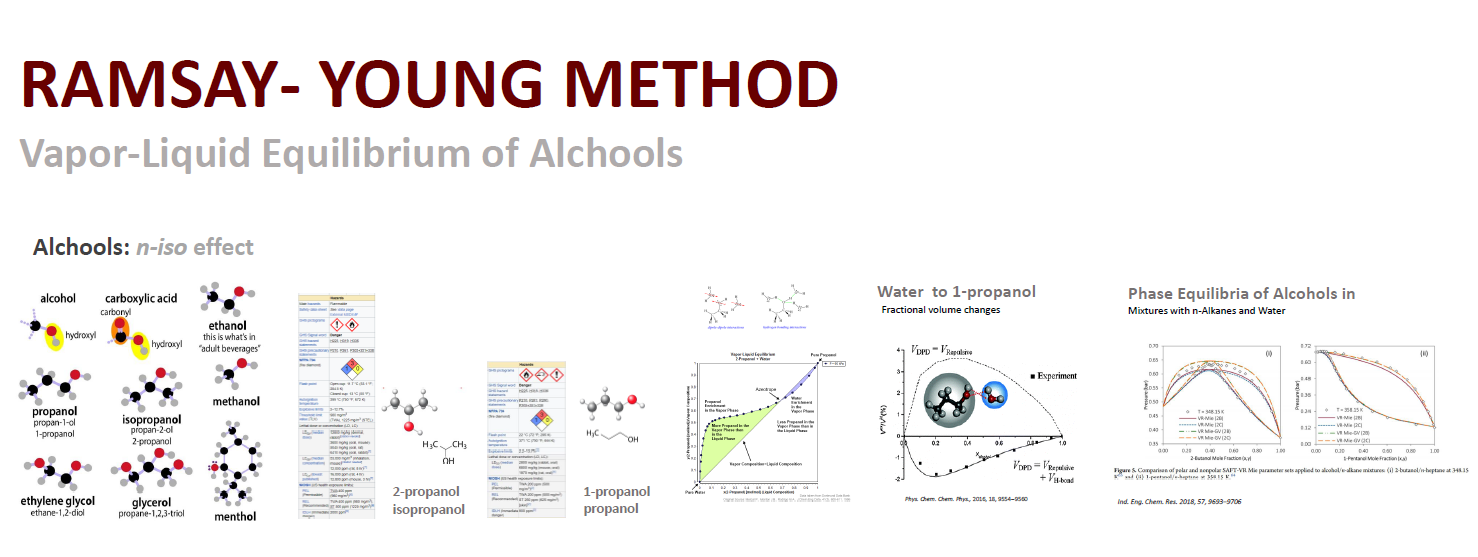
Link to experiment PDF file..Poster
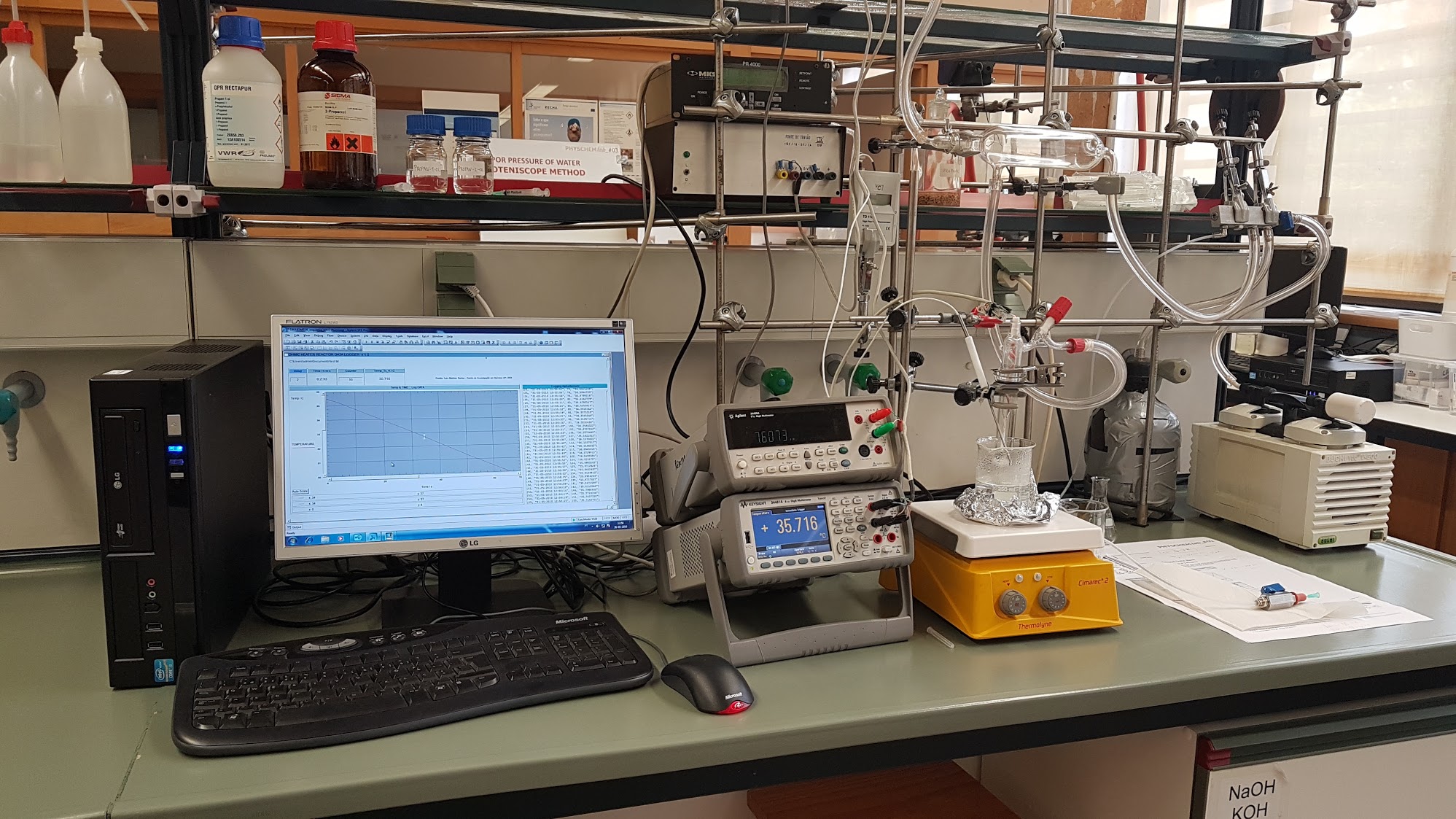
Link to students web page:
Study of volatility of alcohols;
https://sites.google.com/site/alcoholsvolatility/home
Paper #02_01 ... FPE_Coutinho
Paper #02_02 ... PCCP_2016
Paper #02_03 ... SAFT_Diagram
Auxiliar Suporte Materials:Pictures .....Ebulliometer details ... Picture Link ...Pressure sensor (Baratron MKS) ... Picture Link ...Agilent 34405A 5(1/2) Digit Multimeter ... Picture Link ...Keysight 34461A 6(1/2) Digit Multimeter ... Picture Link ...Temperature monitor(Pt1000) ... Picture Link ...Vacuum pump (Membrane double stage) ... Picture Link ...Instrumentations data information ....Baratron MKS Pressure TransducersAgilent 34405A 5½ Digit Multimeter
KEYSIGHT Digital Multimeters 34461A 6 ½
BÜCHI Vac V-500 – Vacuum
VWR digital Thermometer TD110 Pt1000
-
PHYSCHEMlab_#05

Link to experiment PDF file ... Poster das aulas
PAPER_#03_01 ... Mini Bomb
PAPER_#03_02 ... Labtermo
PAPER_#03_03 ... Ballistic bomb calorimetry
PAPER_#03_04 ... Heats of Combustion of Naphthalene
LINK .... Certificate BA NIST
Nist WEBBOOK .... link: https://webbook.nist.gov/chemistry/
Naphthalene ... molar enthalpy of combustion
Pilcher .... source NIST-5156.15 ± 0.92 kJ/mol Ccb Coleman and Pilcher, 1966
LAB_Demo lecture .....PANOPTO link ......
Alerta ...... (para lapso (erro !!!!... :-) ) nos primeiros 6 minutos da aula...
A fórmula estrutural do ácido benzóico está correta!
A fórmula molecular escrita no quadro (C6H6O2) está errada !!
Corrigir para ácido benzóico : C7H6O2
Corrigir o acerto da equação em conformidade.
C7H6O2 (cr) + 15/2 O2 (g) ---> 7CO2 (g) + 3H2O (l)INSTRUMENTATION:
Ballistic Combustion Bomb Gallenkamp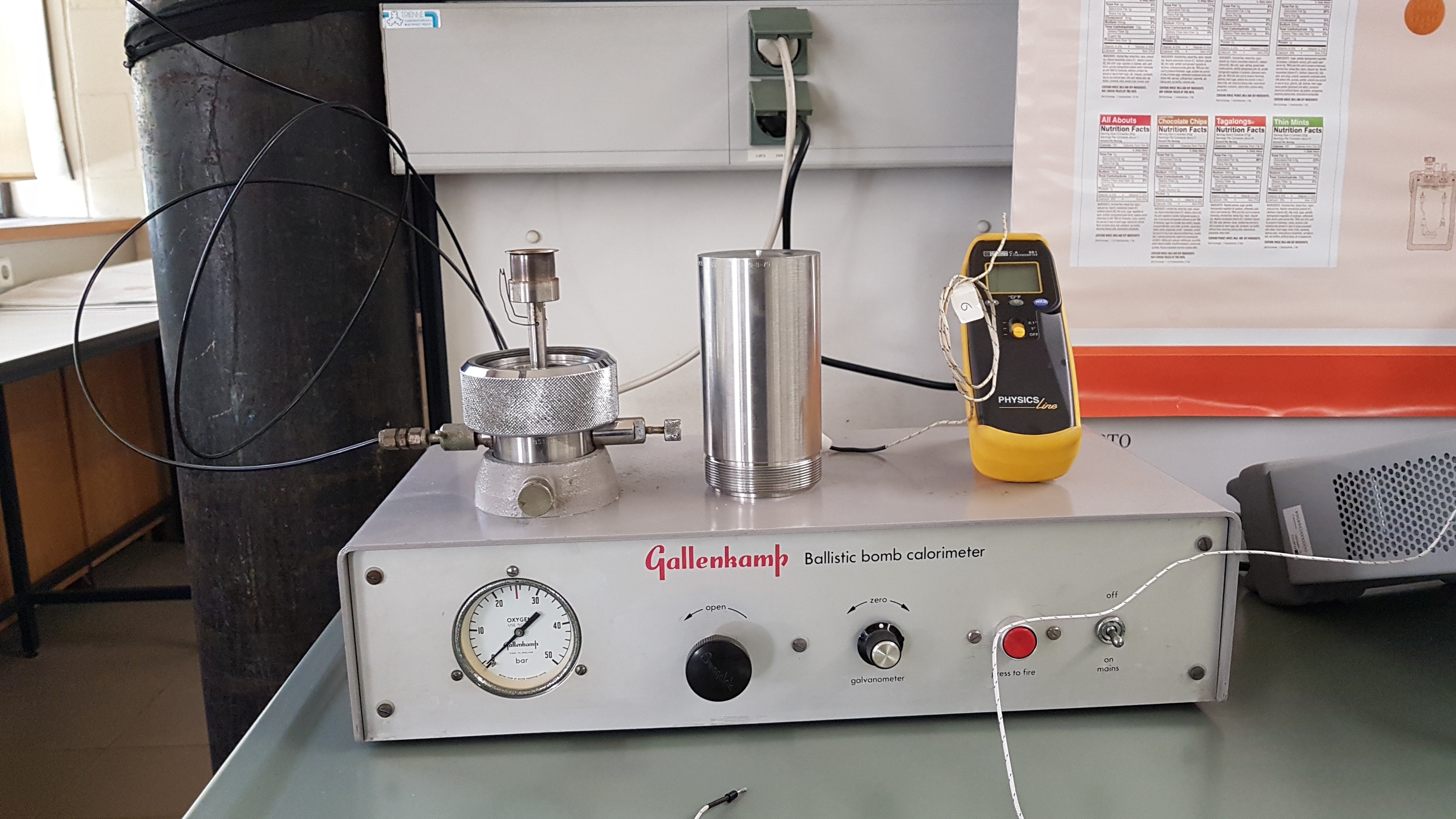 KEYSIGHT Digital Multimeters 34461A 6 ½THERMOCOUPLE type K
KEYSIGHT Digital Multimeters 34461A 6 ½THERMOCOUPLE type K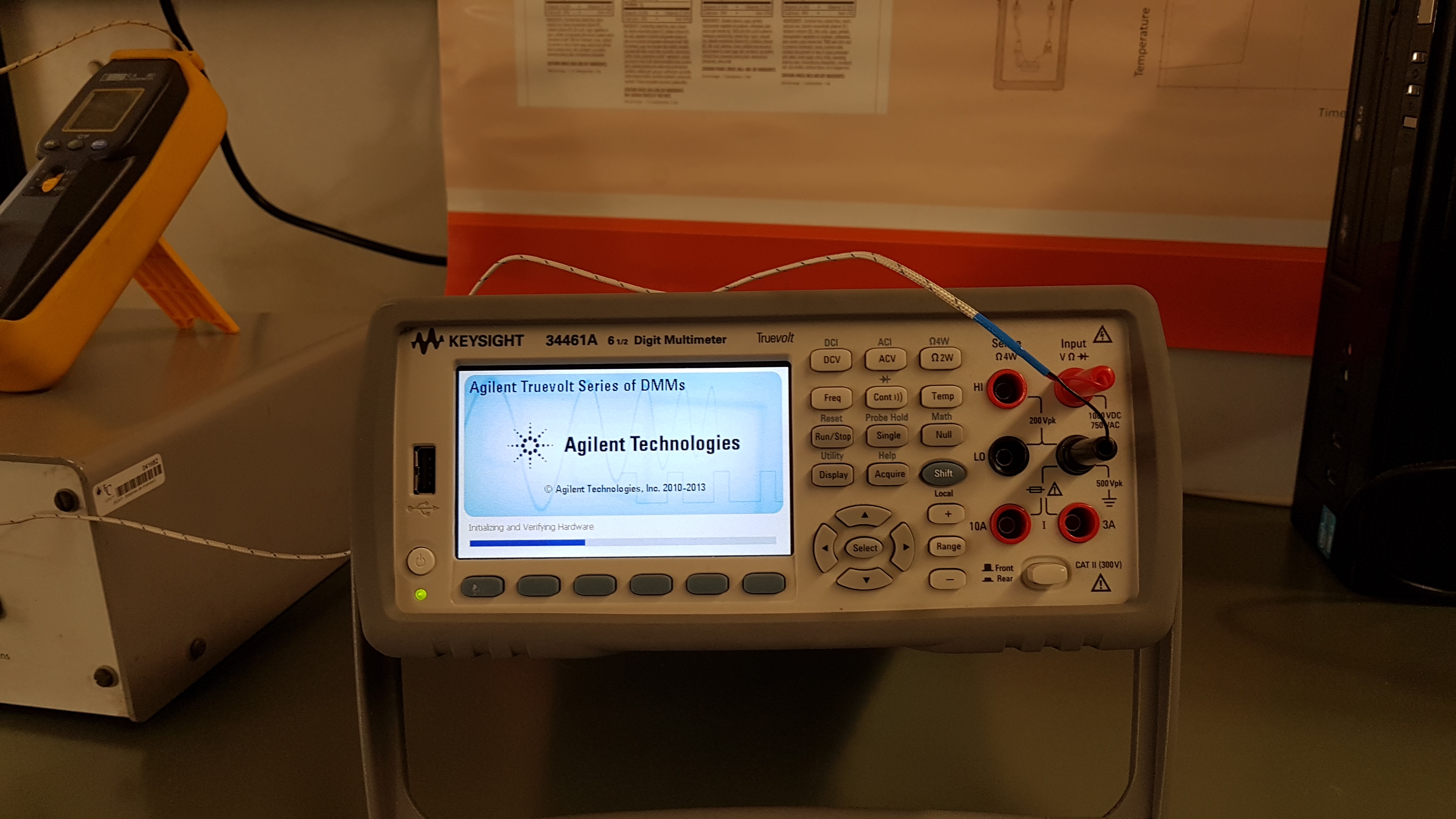
The Type K thermocouple (chromel -alumel)
Type K Accuracy (whichever is greater):
Standard: +/- 2.2C or +/- .75%; Special Limits of Error: +/- 1.1C or 0.4%
Calibration Experiment ....Screen Shot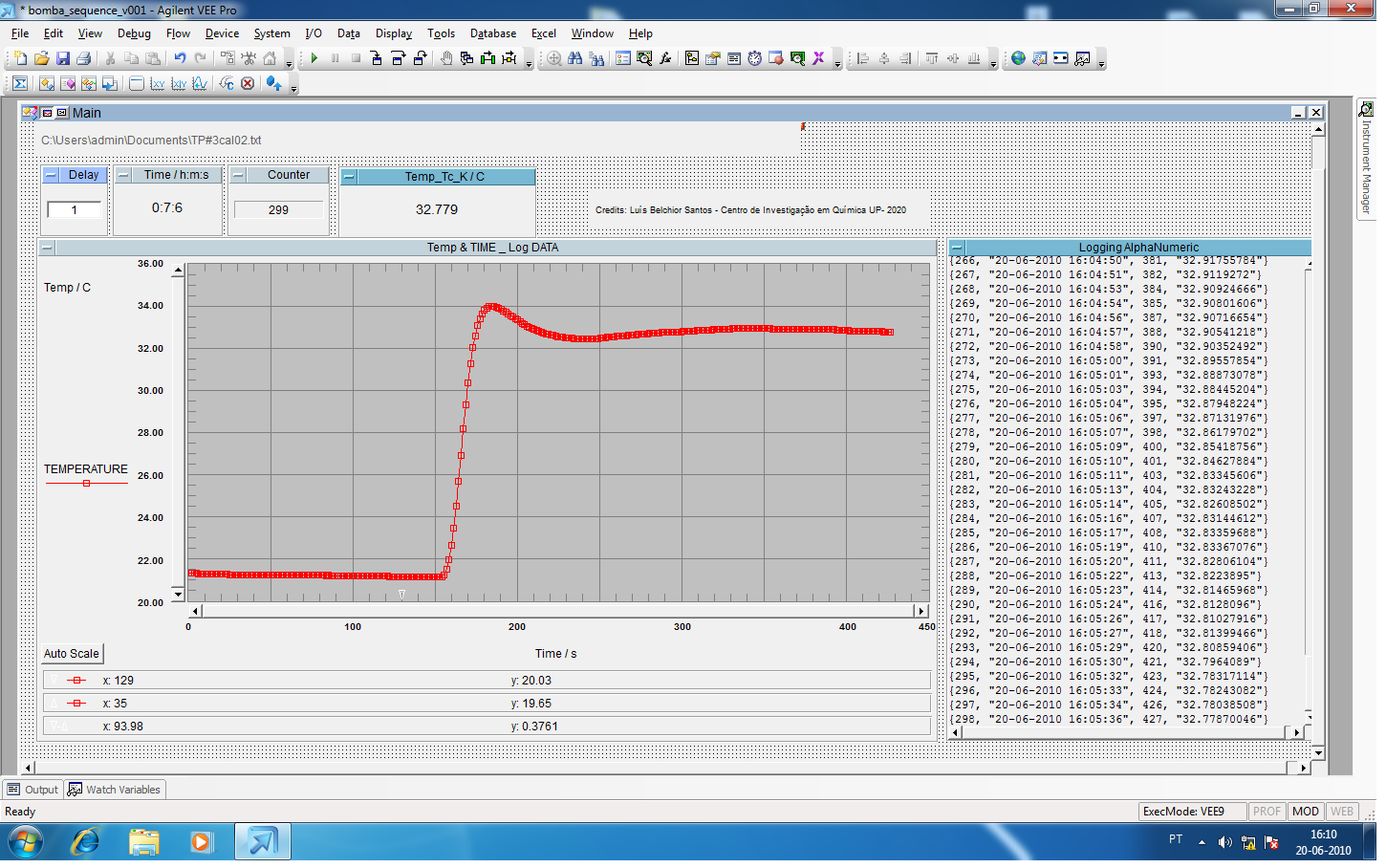
Naphthalene Experiment ....Screen Shot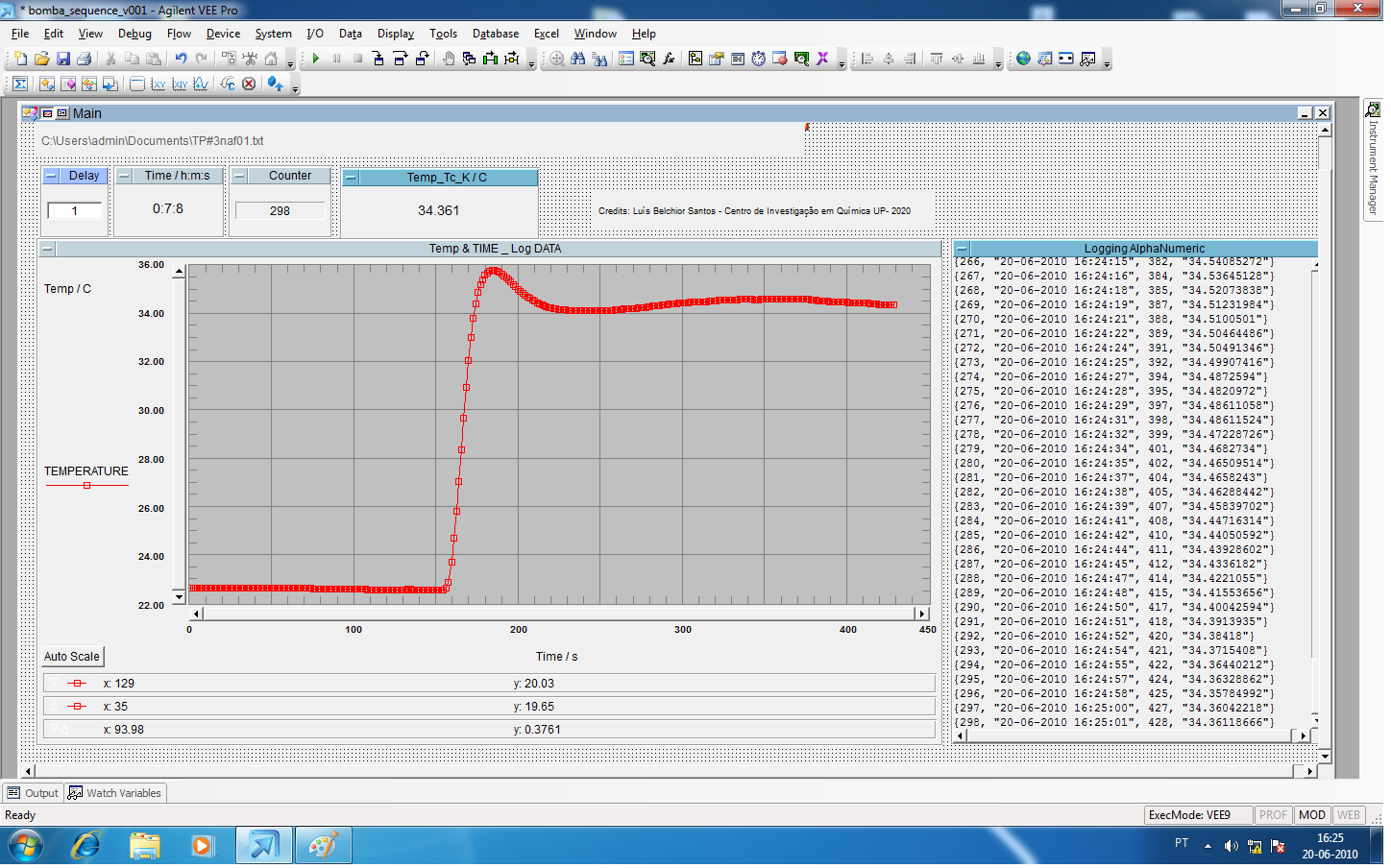
The quantity of energy evolved by combustion of SRM 39j, benzoic acid, when burned under the standard bomb conditions is given below, where g is the gram mass (mass in vacuum). The reduction of weight in air to mass in vacuum was made using the value 1.320 g·cm-3 for the density of benzoic acid at 25 °C.
Certified Value: 26 434 ± 3 J/g
C7H6O2 (cr) + 15/2 O2 (g) ---> 7CO2 (g) + 3H2O (l)
E (J/K) = 26 434 x m(AB) / Δ T (AB)
m(AB) – Experimental mass of benzoic acid (gram)
Δ T (AB) – Temperature change of the calibration experiment
Naphthalene
C10H8 (cr) + 12 O2 (g) ---> 10 CO2 (g) + 4 H2O (l)
u (naf) = - <E> (J/K) x Δ T (naf) / m(naf)
m(naf) – Experimental mass of naphthalene (gram)
Δ T (naf) – Temperature change of the sample experiment
Δ Um = u (naf) x MM (naf) ; Δ Hm = Δ Um + Δ n (g).RT
Δ n = n[CO2 (g)] - n[O2 (g)] = 10 - 12 = - 2 mol
.......................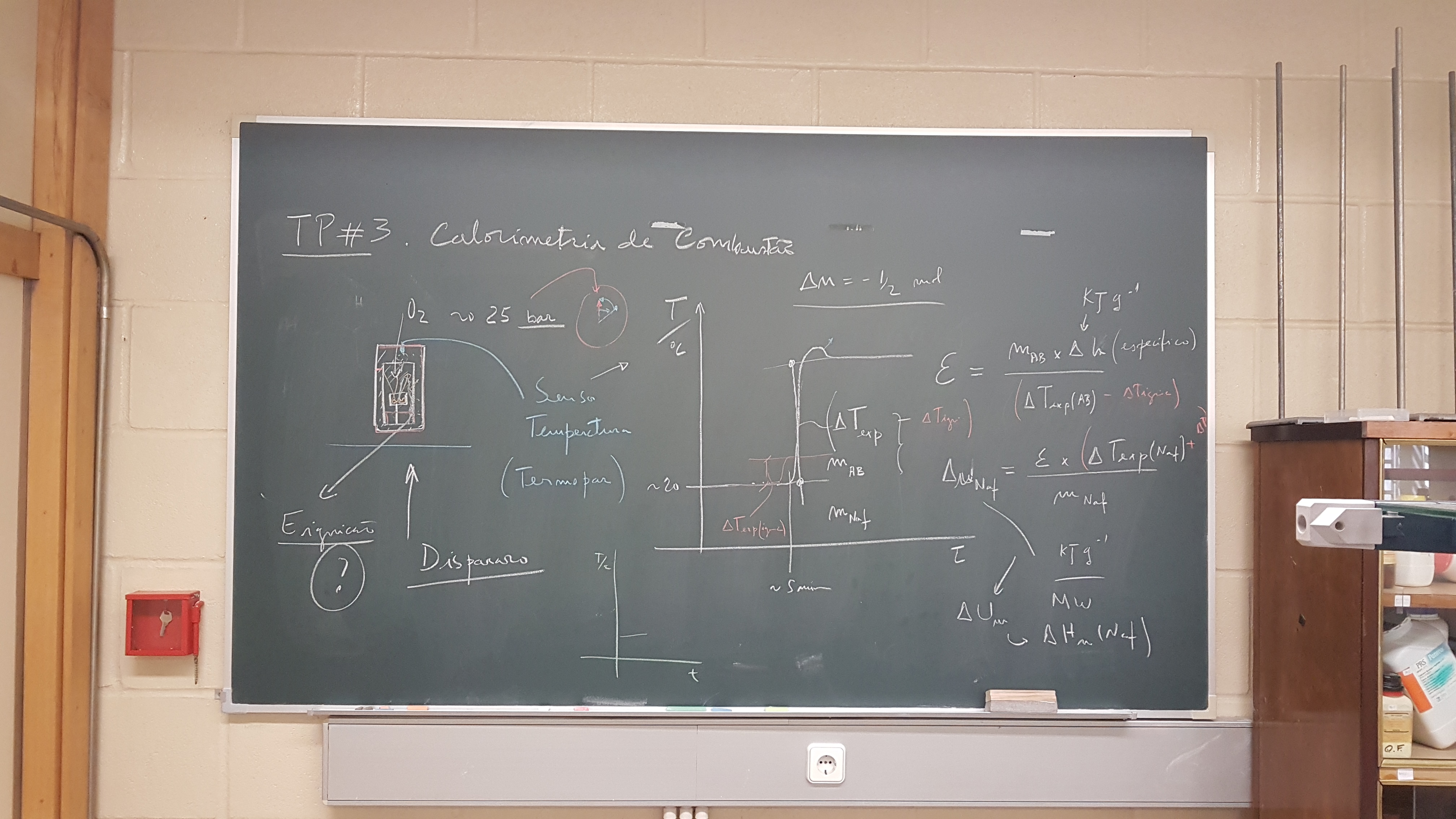
EXPERIMENTAL DATA ...
link to excel File ......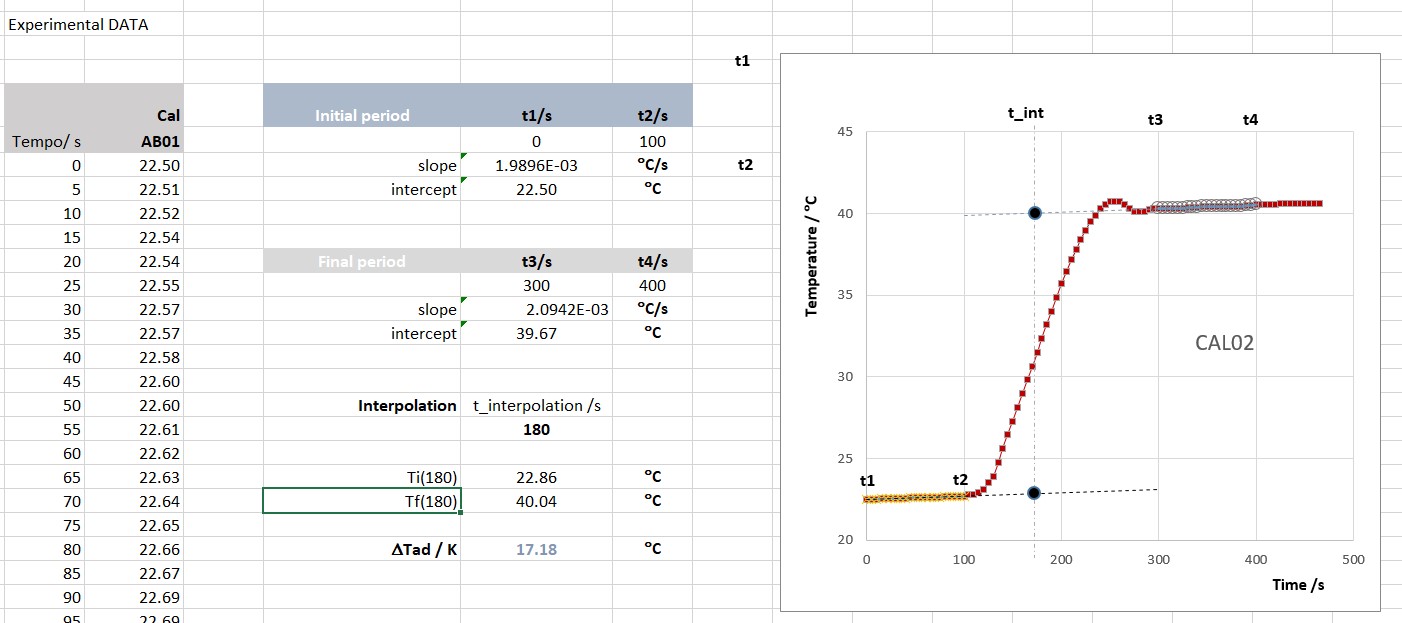
-
PHYSCHEMlab_#06

Link to poster ..... Poster das Aulas
Spectroscopy slides ...link
Experimental notes_link
Kinetics_notes_link
Paper_#06_01 ..JACS 1968 .... Link
Paper_#06_02 ..TALANTA 1996 .... Link
Link to PANOPTO ..... lecture
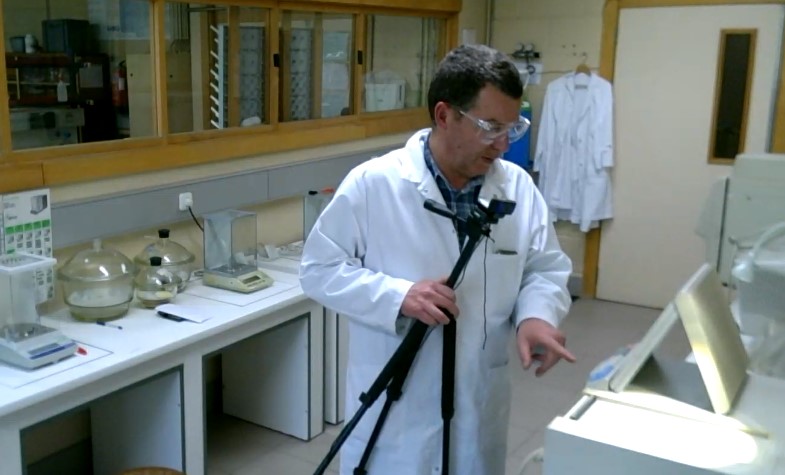
................................................................................................
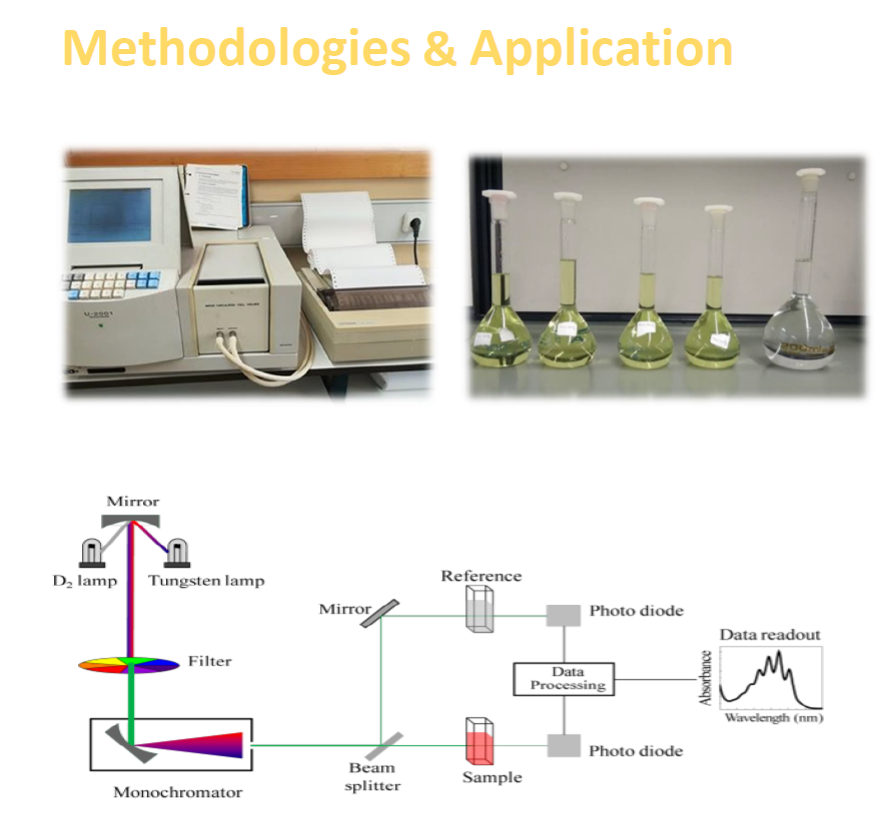

Experimental Results:
Link to Excel file .... NOVA VERSÃO ..MAIS COMPLETA !
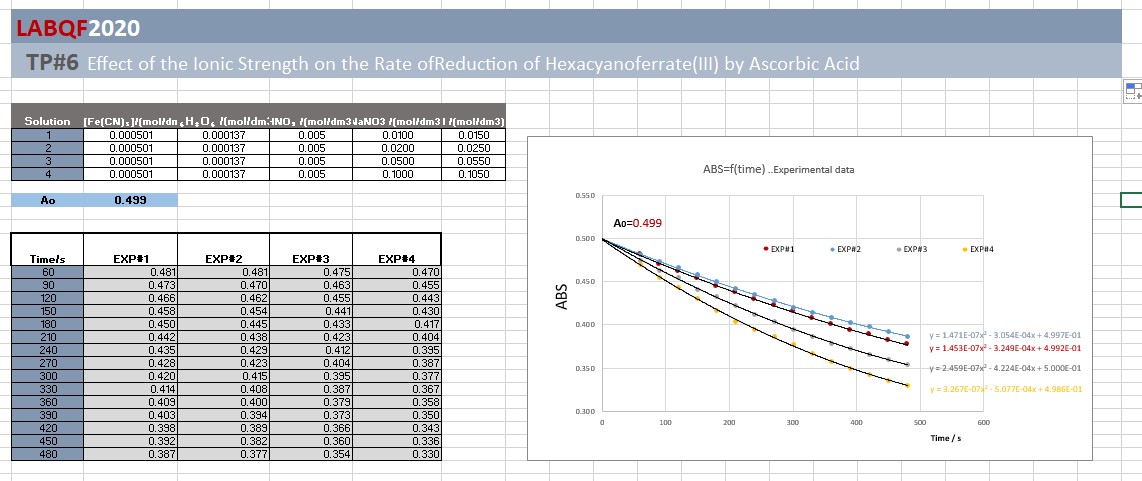
-
Meet Pete Licence
Nice side ...enjoyhttps://www.youtube.com/watch?v=9KpLVkkl2ps

Meet Martyn Poliakoff https://www.youtube.com/watch?v=zvcaXM2hMgA&list=RDCMUCCAgrIbwcJ67zIow1pNF30A&index=4
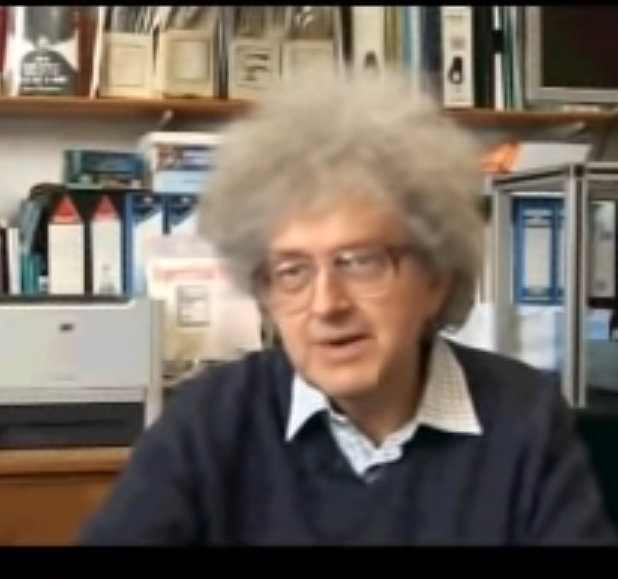
https://www.youtube.com/watch?v=6yT8kvHlgeg
Muito interessante, simples ... merece o vosso tempo e reflexão sobre ciência!
The complete FUN TO IMAGINE with Richard Feynman BBC2 in HIGHER RESOLUTION
All the original episodes and stories in one video - total 66 minutes.Recorded at Feynman's home in Altadena, California, in 1983 and first broadcast on BBC2.
0.50 Jiggling Atoms
7.18 Fire 12.08 Rubber Bands
14.53 Magnets
22.29 Electricity
32.05 Mirror and Train puzzles
37.46 Seeing Things
43.43 Big Numbers
55.01 Ways of Thinking
Thermodynamic Databases:
(Sites úteis de bases de dados termodinâmicos)
a)
NIST .... https://www.nist.gov/
WEIGHTS AND MEASURES
https://www.nist.gov/pml/weights-and-measures/metric-si/si-unitshttps://www.nist.gov/topics/chemistry
https://www.nist.gov/topics/chemical-thermodynamics-chemical-properties
NIST webbook
http://webbook.nist.gov/chemistry/
b) Dortmund Data Bank
http://www.ddbst.com/en/EED/PCP/PCPindex.php
